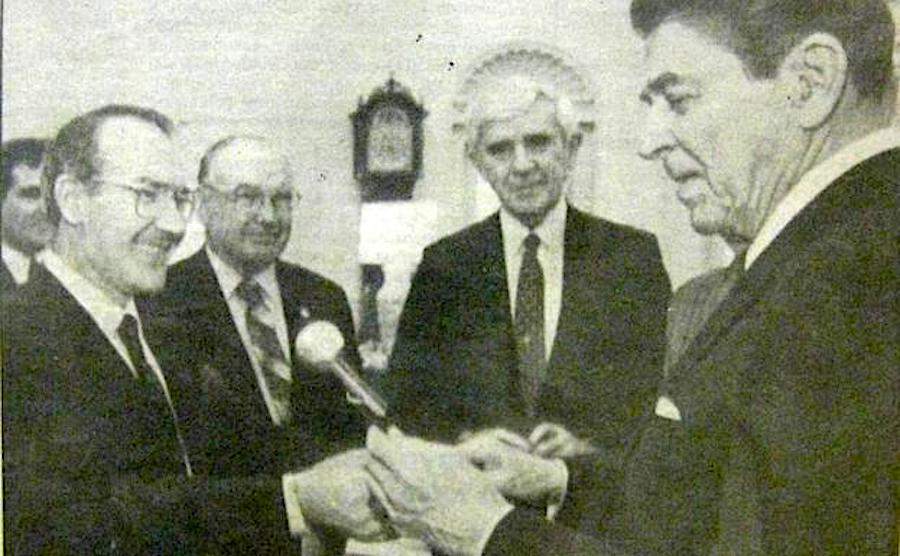This article was translated by John R. Bopp
One of our readers recently reminded us that 2018 marks the 30th anniversary of the first time a Lehendakari of the Basque Government was received at the White House by a US President.
In March 1988, Lehendakari Ardanza made a trip throughout the US over two weeks, visiting all the places where the Basque presence was most felt. It was the first time the highest representative of the Basque Government had visited the US under “normal” circumstances. However, José Antonio Aguirre had been living in that country as the president of the Basque Government in exile during the Second World War, after having fled Europe, the Francoists, and the Nazis.
During Ardanza’s trip, he had arranged meetings with the State Department and with members of the US Congress. But Paul Laxalt, the former governor of Nevada, US Senator, and close personal friend of Reagan’s, managed to get the US president to receive the Lehendakari in an encounter to which Laxalt himself, as well as Pete Cenarrusa, the Idaho Secretary of State, and an active member of the Basque-American community, also attended. News of this meeting was not well received by the Spanish government, at the time led by Felipe González, which tried to keep it from happening.
There are some photos and video filmed by the personnel at the White House from that encounter, which lasted ten minutes, and in which the Lehendakari gave a makila to President Reagan.
Throughout the history of the US, there have been several very special encounters between US presidents and the Basques. We’ve blogged about some of them. And while this list is undoubtedly not exhaustive, it’s a good representation of how such a small nation has had such a large influence on the presidential history of the US.
The first meeting happened right at the country’s start. John Adams, Founding Father and the second president, didn’t just meet Basques like Diego Gardoqui, who were key players in the country’s independence, but he himself also visited the land of the Basquesand included it in his book “A Defense of the Constitutions of the Government of the United States”, in a chapter, “Foral Republic of Biscay”. On the trip that took him to Europe and through Bilbao, John Adams was accompanied by his son, John Quincy Adams, who became the sixth president.
The second connection we’ve blogged about refers to the telegrams Sabino de Arana y Goiri (tried to) send to President Theodore Roosevelt. The first of them congratulated the president for his election win, and was even published by the New York Times. The second, which congratulated him for agreeing to Cuba’s independence, never reached Roosevelt because it wasn’t sent by the Spanish Telegraph office. That telegram cost him jail time.
Anna Eleanor Roosevelt took in Kerman Mirena Iriondo, a Basque “war child” who, at the age of eight, had to leave the Basque Country behind aboard the Habana to flee Francoist violence; she was adopted by the First Lady to promote the implication of her country’s citizens with the children suffering the disasters of the wars in Europe.
During his presidential campaign, Barack Obama gave several speeches about the defense of the plans to reduce the causes of global climate change. One of his biggest speeches about this was held in a factory the Basque company Gamesa has in Pennsylvania. We also need to remember how this president also took home the first Espelette peppers to the White House kitchens, and how he bought almonds from a Basque-descendant farmer in California.
And even though it hasn’t yet been visited by a US president, we can’t help but mention the very traditional Basque barbecue held every year by Adam Paul Laxalt, son of the aforementioned Paul Laxalt, to which aspiring Republican presidents are invited.
International reach and allies are fundamentally important for a nation, especially if it is one without its own state. The weaker you are, the more important it is to have strong friends at your side. That is an unquestionable reality. But when we talk of administrations and governments, friendship is not created between entities but rather people. Part of diplomacy is based on personal relationships, which, alongside economic interests, are the basic elements define and determine it.
This is something that Lehendakari Aguirre and his government understood very well, and which led them to maintain, as far as possible given the hardships of being a government in exile, a policy of close and intense relationship and alliances. And in these, again, the Basque Community played a key role.


Last Updated on Dec 20, 2020 by About Basque Country




























